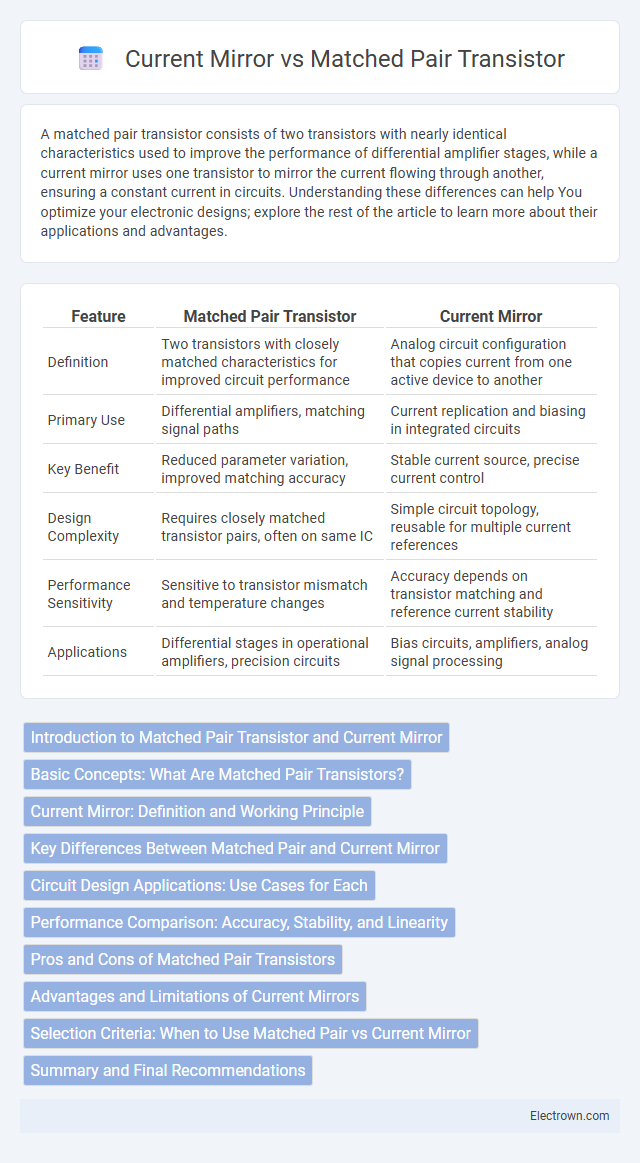A matched pair transistor consists of two transistors with nearly identical characteristics used to improve the performance of differential amplifier stages, while a current mirror uses one transistor to mirror the current flowing through another, ensuring a constant current in circuits. Understanding these differences can help You optimize your electronic designs; explore the rest of the article to learn more about their applications and advantages.
Table of Comparison
| Feature | Matched Pair Transistor | Current Mirror |
|---|---|---|
| Definition | Two transistors with closely matched characteristics for improved circuit performance | Analog circuit configuration that copies current from one active device to another |
| Primary Use | Differential amplifiers, matching signal paths | Current replication and biasing in integrated circuits |
| Key Benefit | Reduced parameter variation, improved matching accuracy | Stable current source, precise current control |
| Design Complexity | Requires closely matched transistor pairs, often on same IC | Simple circuit topology, reusable for multiple current references |
| Performance Sensitivity | Sensitive to transistor mismatch and temperature changes | Accuracy depends on transistor matching and reference current stability |
| Applications | Differential stages in operational amplifiers, precision circuits | Bias circuits, amplifiers, analog signal processing |
Introduction to Matched Pair Transistor and Current Mirror
Matched pair transistors consist of two closely matched bipolar junction transistors (BJTs) fabricated on the same substrate to ensure nearly identical electrical characteristics, enhancing precision in differential amplifier stages. Current mirrors use a matched pair transistor configuration to replicate a reference current accurately, enabling stable biasing and current control in analog circuits. Understanding your application's need for symmetrical transistor behavior or precise current replication determines whether matched pair transistors or current mirrors are the ideal choice.
Basic Concepts: What Are Matched Pair Transistors?
Matched pair transistors are two closely matched bipolar junction transistors (BJTs) or field-effect transistors (FETs) designed to have nearly identical electrical characteristics, such as gain, threshold voltage, and current handling. These transistors are critical in analog circuits for ensuring balanced operation, minimizing offset voltages, and improving linearity. You will find matched pair transistors commonly used in differential amplifiers and current mirrors to maintain precise current replication and stable performance.
Current Mirror: Definition and Working Principle
A current mirror is an electronic circuit designed to copy a current from one active device to another, maintaining constant current regardless of load variations. It operates by forcing the output transistor to mirror the reference current through matched transistor pairs, ensuring accurate current replication in analog circuits. Your designs benefit from current mirrors by achieving stable biasing and improved performance in integrated circuits and amplifiers.
Key Differences Between Matched Pair and Current Mirror
Matched pair transistors are two transistors with closely matched characteristics used to improve circuit symmetry and reduce offset errors, typically found in differential amplifier stages. Current mirrors, however, use a matched pair of transistors to replicate or "mirror" a reference current, providing stable biasing and current regulation across different parts of an integrated circuit. The key difference lies in their application: matched pairs ensure device matching for precise analog performance, while current mirrors focus on maintaining consistent current flow.
Circuit Design Applications: Use Cases for Each
Matched pair transistors are commonly used in differential amplifier circuits, where precise matching of transistor characteristics ensures accurate signal amplification and improved linearity. Current mirrors find applications in biasing and active load circuits, providing stable reference currents and enhancing the overall performance of analog integrated circuits. Your choice between these components depends on whether the focus is on balanced signal processing or maintaining constant current levels in the design.
Performance Comparison: Accuracy, Stability, and Linearity
Matched pair transistors excel in accuracy due to their closely matched electrical characteristics, reducing offset voltages and enhancing signal fidelity in differential circuits. Current mirrors offer superior stability across temperature variations and supply voltage changes, maintaining consistent current ratios essential for biasing applications. In terms of linearity, matched pairs provide better linear responses in differential amplifiers, while current mirrors may introduce distortion under high output voltage swings, affecting signal integrity.
Pros and Cons of Matched Pair Transistors
Matched pair transistors offer precise parameter matching, leading to improved differential amplifier performance and reduced offset voltage, which enhances signal accuracy in analog circuits. However, they can be more expensive and difficult to source compared to standard transistors and are sensitive to temperature variations that may affect long-term reliability. Your choice between matched pairs and current mirrors depends on whether precision or practicality is more critical for your specific circuit application.
Advantages and Limitations of Current Mirrors
Current mirrors offer precise current replication, simplifying circuit design and saving space compared to matched pair transistors, which require meticulous matching and often take up more area. They provide high output resistance and improved accuracy in biasing and active load applications but suffer from issues such as limited bandwidth, temperature dependence, and mismatch errors due to process variations. Despite these limitations, current mirrors remain essential for stable current sources in analog and mixed-signal integrated circuits.
Selection Criteria: When to Use Matched Pair vs Current Mirror
Matched pair transistors are preferred when precise matching of gain and threshold voltage is critical, such as in differential amplifier stages or analog signal processing circuits. Current mirrors are ideal for providing accurate and stable reference currents in biasing networks and active loads, ensuring consistent operation in integrated circuits. Your choice depends on whether the application demands closely matched transistor parameters or accurate current replication for circuit stability.
Summary and Final Recommendations
Matched pair transistors provide precise device matching ideal for differential amplifier stages, ensuring minimal offset voltage and high linearity. Current mirrors offer stable biasing and current replication with excellent output resistance, crucial for accurate current control in integrated circuits. Your choice depends on application requirements: use matched pairs for differential signal fidelity and current mirrors for consistent current sourcing or sinking.
matched pair transistor vs current mirror Infographic

 electrown.com
electrown.com